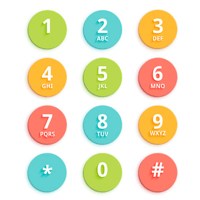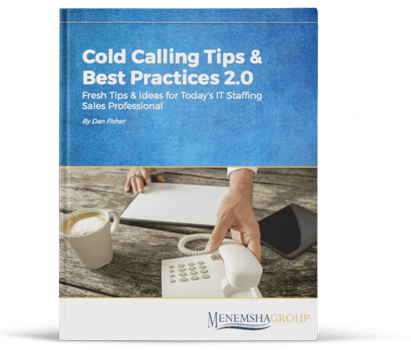Cold Calling Tips & Best Practices

Introduction
It has been close to eight years since I wrote my first ebook, Cold Calling Tips & Techniques. A lot has changed in that time for IT staffing sales professionals which is why I decided to write a new and improved version (2) filled with fresh ideas and the latest research.
What’s been interesting since I wrote that first ebook eight years ago is all the debate that has started over whether or not cold calling is even relevant anymore. Perhaps you have seen the advertisements on Google and Linked that read “cold calling is dead.” The so called “experts” and “gurus” say that salespeople should never make cold calls because customers despise receiving them and sales people don’t enjoy making them. They go on to say that cold calling no longer works and that it is not a productive use of time.
To be crystal clear, what these so called experts mean and what we at Menemsha Group completely agree with is-sales people shouldn’t be blindingly picking up the phone and randomly calling phone numbers pitching prospects without any knowledge of the prospect or his or her company.

The plethora of data that is available for free online should be helping sales reps turn cold calls into warm calls (a lot more on this shortly). Salespeople now have the power to conduct pre-call research and learn important details about a lead before ever picking up the phone. Finally, today’s sales professional must be more targeted with their calls and their messaging and create not only a valuable but a memorable experience for the prospect.
In this guide I am going to share with you the strategies and tactics used by top performers to improve your prospecting efficiency. In this guide you will learn:
- How and why you need to have a clearly defined target market
- How and why you must score your leads
- How to set call objectives
- How and why you need to create a sales call plan (and track and measure completion)
- How to demonstrate value and create a memorable experience for your prospects
- How to apply metrics to track and improve your prospecting effectiveness
- What buyer personas are, why they are so important, and why they’re the key to successful prospecting for IT staffing sales professionals
Finally, before we begin, there is no magic formula to guarantee 100 percent effectiveness on every sales call, cold or warm. But there is a methodology you can follow to drastically improve your sales prospecting results. If you apply the tips and best practices laid out in this book I am confident you will see an improvement in your results.
It has been close to eight years since I wrote my first ebook, Cold Calling Tips & Techniques. A lot has changed in that time for IT staffing sales professionals which is why I decided to write a new and improved version (2) filled with fresh ideas and the latest research.
What’s been interesting since I wrote that first ebook eight years ago is all the debate that has started over whether or not cold calling is even relevant anymore. Perhaps you have seen the advertisements on Google and Linked that read “cold calling is dead.” The so called “experts” and “gurus” say that salespeople should never make cold calls because customers despise receiving them and sales people don’t enjoy making them. They go on to say that cold calling no longer works and that it is not a productive use of time.
To be crystal clear, what these so called experts mean and what we at Menemsha Group completely agree with is-sales people shouldn’t be blindingly picking up the phone and randomly calling phone numbers pitching prospects without any knowledge of the prospect or his or her company.

The plethora of data that is available for free online should be helping sales reps turn cold calls into warm calls (a lot more on this shortly). Salespeople now have the power to conduct pre-call research and learn important details about a lead before ever picking up the phone. Finally, today’s sales professional must be more targeted with their calls and their messaging and create not only a valuable but a memorable experience for the prospect.
In this guide I am going to share with you the strategies and tactics used by top performers to improve your prospecting efficiency. In this guide you will learn:
- How and why you need to have a clearly defined target market
- How and why you must score your leads
- How to set call objectives
- How and why you need to create a sales call plan (and track and measure completion)
- How to demonstrate value and create a memorable experience for your prospects
- How to apply metrics to track and improve your prospecting effectiveness
- What buyer personas are, why they are so important, and why they’re the key to successful prospecting for IT staffing sales professionals
Finally, before we begin, there is no magic formula to guarantee 100 percent effectiveness on every sales call, cold or warm. But there is a methodology you can follow to drastically improve your sales prospecting results. If you apply the tips and best practices laid out in this book I am confident you will see an improvement in your results.
 Increasing revenue and improving your sales prospecting effectiveness starts by focusing on the things that you can exert 100% control over. Sales people have 100% control over how many times they pick up the phone. My data, which is culled from my eight plus years coaching thousands of sales reps in the staffing industry and it tells me that it takes on average 25 raw dials to get on decision maker on the phone. If your goal is to have 5 connects in a day, do the math. You can’t put deals together purely through email or social media. Sales people must first pick up the phone and engage their prospects.
Increasing revenue and improving your sales prospecting effectiveness starts by focusing on the things that you can exert 100% control over. Sales people have 100% control over how many times they pick up the phone. My data, which is culled from my eight plus years coaching thousands of sales reps in the staffing industry and it tells me that it takes on average 25 raw dials to get on decision maker on the phone. If your goal is to have 5 connects in a day, do the math. You can’t put deals together purely through email or social media. Sales people must first pick up the phone and engage their prospects.
Timeliness of Lead Follow-up
If your company is generating leads from the company website then the salesperson must respond to those leads within 5 minutes. A study was conducted by Dr. James Oldroyd of the Massachusetts Institute of Technology (MIT) and Insidesales.com and the study found that if you wait 30 minutes, you are 10 times less likely to reach that person. Also, if you call someone back within five minutes, the odds of qualifying that person are 21 times greater.
How fast does the average salesperson respond to a lead?
Answer: 39 hours and 22 minutes.
Call Times
Additional studies conducted by Insidesales.com have shown that sales people have the best chance of reaching a prospect at the beginning and end of the day. For example, you have a 114 percent greater chance of making contact between 4 and 6 pm than you do at the worst time, which is between 11 am and noon. These numbers do very slightly by industry but as a general rule, you should be making your prospecting calls at the beginning of the day and late in the afternoon and into the evening.
 I have always said, “Sales people need to work the same hours as their customers.” This means salespeople should be making calls starting as early at 6:30am and as late as 8:00 pm.
I have always said, “Sales people need to work the same hours as their customers.” This means salespeople should be making calls starting as early at 6:30am and as late as 8:00 pm.
Finally, their research went on to show that Tuesday is the worst day to make a sales call and Wednesdays and Thursdays are the best days for sales prospecting. On average, sales reps are 50 percent more likely to both contact and qualify a lead on Wednesday than on Tuesday.
Persistence Pays
Here are some interesting statistics from the American Management Association
- 48% of salespeople never follow up with a prospect
- 25% of salespeople make a second contact and stop
- 12% of sales people only make three contacts and stop
- Only 10% of sales people make more than three contacts
- 2% of sales are made on the first contact
- 3% of sales are made on the second contact
- 5% of sales are made on the third contact
- 10% of sales are made on the fourth contact
- 80% of sales are made between the fifth and twelfth contact
Direct Dial Phone Numbers
 Another study was recently conducted by Vorsight and Insidesales.com to determine why six of their sales reps were so much more successful than other sales reps. What they discovered was instead of calling the front desk and getting stuck with a receptionist, these sales reps found ways to find the direct-dial phone numbers for each of the people they were trying to contact. This led to 3 times as many meetings per month.
Another study was recently conducted by Vorsight and Insidesales.com to determine why six of their sales reps were so much more successful than other sales reps. What they discovered was instead of calling the front desk and getting stuck with a receptionist, these sales reps found ways to find the direct-dial phone numbers for each of the people they were trying to contact. This led to 3 times as many meetings per month.
They had gone through the discipline of finding the direct-dial phone number, either asking for it or searching for it on Google. Get direct dial phone numbers- it clearly pays!
 Prospecting and cold calling in particular has become extremely counterproductive for sales professionals. A big reason why it has become counterproductive is because sales reps simply don’t know which accounts to target or who to target in those accounts. In fact a study conducted by The American Marketing Association concluded that sales people are spending 40% of their time preparing customer facing materials. Why? Without a clearly defined target market sales professionals have to create materials and answers “on the fly” in order to appease their prospective customers.
Prospecting and cold calling in particular has become extremely counterproductive for sales professionals. A big reason why it has become counterproductive is because sales reps simply don’t know which accounts to target or who to target in those accounts. In fact a study conducted by The American Marketing Association concluded that sales people are spending 40% of their time preparing customer facing materials. Why? Without a clearly defined target market sales professionals have to create materials and answers “on the fly” in order to appease their prospective customers.
To overcome this paralysis by analysis top performers create a clearly defined target market.
Armed with a clearly defined target market, sales professionals can quickly and easily build a prospect call list filled with companies who share many of the same qualities of their most loyal customers.
 Lead scoring allows you to assign a value (a certain number of points) to each lead (before they become a qualified prospect). Lead scoring helps sales rep’s, sales managers and marketing teams prioritize leads and increase efficiency.
Lead scoring allows you to assign a value (a certain number of points) to each lead (before they become a qualified prospect). Lead scoring helps sales rep’s, sales managers and marketing teams prioritize leads and increase efficiency.
Top performing sales teams use lead scoring and apply a point system for assigning values to their leads and accounts including the different demographics associated with a lead. Lead scoring coupled with defining your target market significantly increases prospecting efficiency and effectiveness. But it doesn’t stop there.
Buyer personas are generalized representations of your ideal customers. They help you understand your customers (and prospective customers) better, and make it easier for you to tailor your messaging (verbal, email, voice mail and content) to the specific needs, behaviors, and concerns of the different IT hiring managers or the specific buyers that you sell to.
 At the most basic level, personas allow you to personalize or target your sales messaging and marketing for different segments of your audience. For example, instead of sending the same lead nurturing emails to everyone in your database, you can segment your emails and subsequently the message you send by buyer persona and tailor your messaging according to what you know about those different personas.
At the most basic level, personas allow you to personalize or target your sales messaging and marketing for different segments of your audience. For example, instead of sending the same lead nurturing emails to everyone in your database, you can segment your emails and subsequently the message you send by buyer persona and tailor your messaging according to what you know about those different personas.
We know how challenging it is to get a prospect to return a call or respond to an email messages. Even when sales people do get a prospect on the phone it is still very difficult to get the prospect to engage in a meaningful conversation. The key to unlocking this challenge is building out buyer personas. When sales people understand what is important to their buyer, the challenges they face and the concerns they have it becomes much easier to structure relevant question and get them to engage in a productive discussion. Top performers are brilliant at executing this step.
 Are you worth talking to? That is the question going through the mind of corporate buyers and IT hiring managers when they receive calls, emails and voicemail messages from sales professionals. Top performers know this which is why they don’t show up to a gunfight with a knife. When top performers make cold calls and prospect for new business they do so with a value proposition that:
Are you worth talking to? That is the question going through the mind of corporate buyers and IT hiring managers when they receive calls, emails and voicemail messages from sales professionals. Top performers know this which is why they don’t show up to a gunfight with a knife. When top performers make cold calls and prospect for new business they do so with a value proposition that:
- Articulates the problem(s) they have solved for other like-minded customers
- Demonstrates how their staffing solution solved a business problem and/or helped the client achieved a business goal
- Uses metrics or statistics to quantify their value
If your goal is to have more customer face time, more productive and meaningful sales conversations and to build the top of your sales funnel with qualified opportunities then IT staffing sales professionals must complete call plans and sales managers must track and measure the completion of those call plans.
What goes in a call plan? Below is a sample call plan to give you an idea.
In this section you will discover that many of the same attributes to executing a strong cold call are the same today as they were eight years ago.
Adjust Your Mindset
 The first thing you need to do is change your mind set and mental approach to cold calling. Don’t approach cold calling with the goal of making a sale or landing a meeting. Those are certainly goals you want to achieve with every prospect but if that is your goal on the cold call, you are destined to put yourself in constant objection handling mode which will mostly likely lead to failure.
The first thing you need to do is change your mind set and mental approach to cold calling. Don’t approach cold calling with the goal of making a sale or landing a meeting. Those are certainly goals you want to achieve with every prospect but if that is your goal on the cold call, you are destined to put yourself in constant objection handling mode which will mostly likely lead to failure.
If your goal of the cold call is not to make a sale then how can you get rejected? Eliminating the goal of “making a sale” or “landing a meeting” on a cold call will free you from the fear of rejection. Lower your expectations and take the pressure off yourself. Share with your prospects that you are in it for the long haul.
Stop Selling and Impress Them by Sharing What You Know About Them
We all know how competitive it is out there. Your customers and prospects are getting dozens of calls from your competitors each week. Furthermore, your customers and prospects cannot distinguish one vendor from the next because they all sound alike. They all lead with their company accolades and service offerings. This is a very salesy approach and a turn-off to just about any buyer.
To distinguish yourself, share with your prospect all of the information you learned about him or her from your research. Talk about stroking the ego! Your script may sound something like this:
“Hi Mr. Customer, this is Dan Fisher calling from Menemsha Group. The reason for my call today is I have been doing a fair amount of research on you and your company and I understand
- You’re responsible for_____
- You manage a team of_____
- You’re using ___ technology
- You’re in the midst of ___ project
- Your company is ___ in revenue and has ____employees
- Your company recently announced _______
The information you share doesn’t have to be earth shattering so don’t get hung up on that. Just share something, anything. The point is you want them to know that you are thinking about them and you’ve come to the call prepared. That in itself will differentiate you. How many sales calls do you think a hiring manager receives where sales reps starts educating him or her on what they know about that manager and their company? Very, very few.
Your Goal is to Disarm the Prospect
Disarming means to relieve your prospect of anxiety, pressure or hostility, and to make them feel comfortable. You can accomplish this by making the prospect feel like they have control over the call by giving them permission to end the call at any point in time. I refer to this as doing the opposite of what prospects expect.
In my original cold calling tips guide I suggested that “sales people display a lot of respect for their contact’s time.” We still want to show respect but this sentence can easily be taken out of context so let me be clear. Do NOT act needy or sound like you need the prospect more than they need you. Do NOT act like the prospect’s time is more important than yours because it’s not. Do not use the words “Just” or “Love.” For example, don’t say “I just want….” When sales people say this it minimizes the importance and purpose of their call. Second, don’t say “I would love to…” This is a perfect example of a statement that makes the sales reps sound needy and desperate. When sales people say “I would love to meet with you” it comes off as very self-serving because it focuses on the wants of the sales rep, not the customer.
One good tactic to disarm prospects is to always be asking their permission to move forward. If you are always asking for their permission they will never have anything to object to. Now the skeptics out there (especially the old dogs ) will say “I’m not going to do that because if I ask for their permission they will say no and the call will end.” Hey, I’ve been doing this a long time; trust me, this works amazingly well.
Please complete the form to the right to download this ebook.

Conclusion
If you want to increase the top of your sales funnel in the most efficient way possible then following the steps in this eBook for effective cold calling and sales prospecting should absolutely be a priority.
- In this book, we discussed:
- Optimal times to call on prospects
- The importance of prospecting persistency
- Expectations around call volumes
- Building call plans
- The use of value propositions
- Building buyer personas
- Lead scoring
- Executing a cold call
We also talked about the key elements of executing a cold call including the importance of disarming the prospect and eliminating common statements or phrases such as “I’d love to…” or “I just want…”



